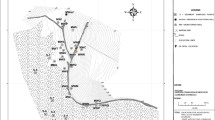Abstract
A demonstration of artificial groundwater recharge with tertiary effluent was evaluated using a set of bioassays (acute toxicity to Daphnia, genotoxicity, estrogenic and antiestrogenic toxicity). Around 95 % genotoxicity and 53 % antiestrogenicity were removed from the feed water by ozonation, whereas significant reduction of acute toxicity to Daphnia magna was achieved during a 3 days vadose soil treatment. The toxicity was further removed to the same level as the local groundwater during a 20 days aquifer soil treatment. The pilot study has shown that ozonation and soil treatments can improve the quality of municipal wastewater treatment plant effluents for possible groundwater recharge purposes.


Similar content being viewed by others
References
Barber LB, Keefe SH, Leblanc DR, Bradley PM, Chapelle FH, Meyer MT, Loftin KA, Kolpin DW, Rubio F (2009) Fate of sulfamethoxazole, 4-nonylphenol, and 17 β-estradiol in groundwater contaminated by wastewater treatment plant effluent. Environ Sci Technol 43:4843–4850
Cao N, Yang M, Zhang Y, Hu JY, Ike M, Hirotsuji J, Matsui H, Inoue D, Sei K (2009) Evaluation of wastewater reclamation technologies based on in vitro and in vivo bioassays. Sci Total Environ 407:1588–1597
Escher BI, Bramaz N, Ort C (2009) Monitoring the treatment efficiency of a full scale ozonation on a sewage treatment plant with a mode-of-action based test battery. J Environ Monit 11:1836–1846
Gersich FM, Hopkins DL (1986) Site-specific acute and chronic toxicity of ammonia to Daphnia magna straus. Environ Toxicol Chem 5:443–447
ISO (2000) Water quality-determination of the genotoxicity of water and waste water using the umu-test, 1st edn. ISO 13829, Geneva, Switzerland, pp 1–18
Jin Sung R, Byoung Cheun L, Nam Ik C, Sang Don K (2008) Comparative whole effluent toxicity assessment of wastewater treatment plant effluents using Daphnia magna. Bull Environ Contam Toxicol 80:196–200
Lim TH, Gin KYH, Chow SS, Chen YH, Reinhard M, Tay JH (2007) Potential for 17 β-estradiol and estrone degradation in a recharge aquifer system. J Environ Eng ASCE 133:819–826
Mansell BL, Drewes JE (2004) Fate of steroidal hormones during soil-aquifer treatment. Ground Water Monit Rem 24:94–101
Metcalfe CD, Metcalfe TL, Kiparissis Y, Koenig BG, Khan C, Hughes RJ, Croley TR, March RE, Potter T (2001) Estrogenic potency of chemicals detected in sewage treatment plant effluents as determined by in vivo assays with Japanese medaka (Oryzias latipes). Environ Toxicol Chem 20:297–308
Ministry of Environmental Protection PR China (2002) Standard methods of water and wastewater monitoring of China, 4th edn. China Environmental Science Press, Beijing, pp 243–284
Organisation for Economic Co-operation and Development (OECD) (2004) OECD Guideline for testing of chemicals 202: Daphnia sp., acute immobilisation test. pp 1–12
Scott G, Crunkilton RL (2000) Acute and chronic toxicity of nitrate to fathead minnows (Pimephales promelas), Ceriodaphnia dubia, and Daphnia magna. Environ Toxicol Chem 19:2918–2922
Wu QY, Hu HY, Zhao X, Sun YX (2009) Effect of chlorination on the estrogenic/antiestrogenic activities of biologically treated wastewater. Environ Sci Technol 43:4940–4945
Wu QY, Li Y, Hu HY, Sun YX, Zhao FY (2010) Reduced effect of bromide on the genotoxicity in secondary effluent of a municipal wastewater treatment plant during chlorination. Environ Sci Technol 44:4924–4929
Yang M, Wang K, Shen Y, Wu M (2011) Evaluation of estrogenic activity in surface water and municipal wastewater in Shanghai, China. Bull Environ Contam Toxicol 87:215–219
Zhang X, Warming TP, Hu HY, Christoffersen KS (2009) Life history responses of Daphnia magna feeding on toxic Microcystis aeruginosa alone and mixed with a mixotrophic Poterioochromonas sp. Water Res 43:5053–5062
Zhang X, Zhao X, Zhang M, Wu QY (2011) Safety evaluation of an artificial groundwater recharge system for reclaimed water reuse based on bioassays. Desalination 281:185–189
Zhao X, Cheng XZ, Zhang M (2009) A case study: bulk organic matters and nitrogen removal from reclaimed water by enhanced direct injection-well groundwater recharge system. Water Sci Technol 60:745–749
Acknowledgments
This research was supported by the National Natural Science Foundation of China (Grant No. 51078211 and 51208279) and the Research Fund for the Doctoral Program of Higher Education of China (Grant No. 20110002120020). The authors would like to thank Prof. Hu Hong-ying and Dr. Qian-yuan Wu for their support in the bioassays.
Author information
Authors and Affiliations
Corresponding author
Rights and permissions
About this article
Cite this article
Zhang, X., Zhao, X. Ecotoxicity Assessment of Artificial Groundwater Recharge with Reclaimed Water: A Pilot-Scale Study. Bull Environ Contam Toxicol 91, 499–502 (2013). https://doi.org/10.1007/s00128-013-1109-1
Received:
Accepted:
Published:
Issue Date:
DOI: https://doi.org/10.1007/s00128-013-1109-1




